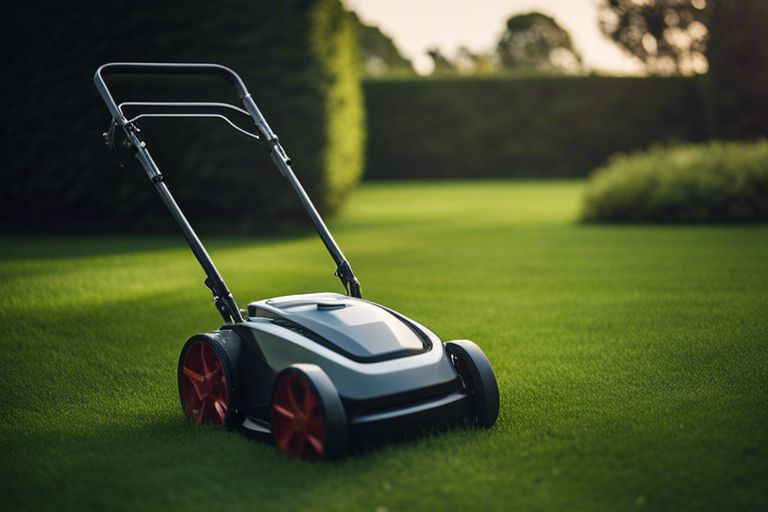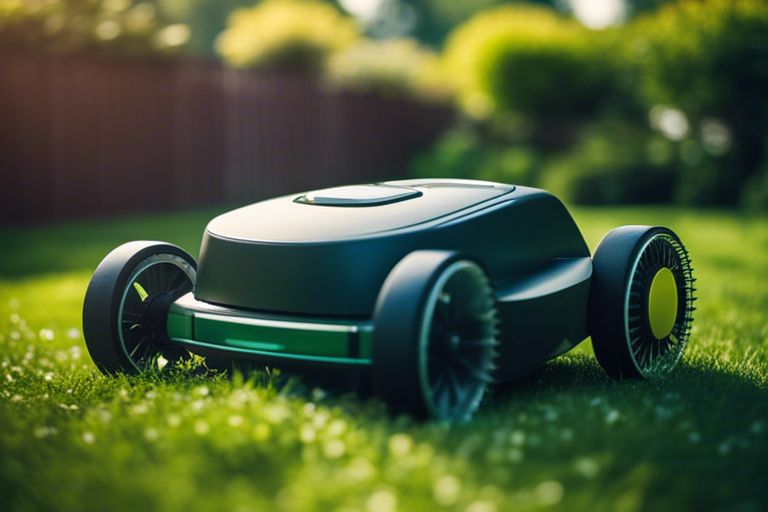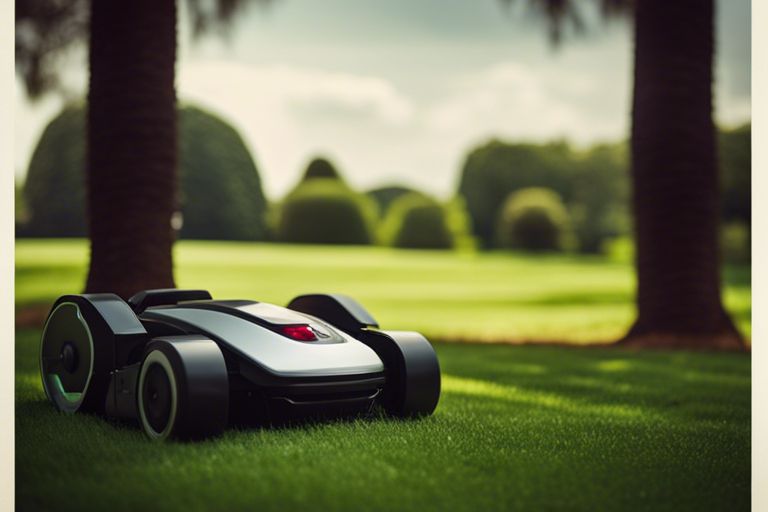Many recent advancements in artificial intelligence technology have revolutionized the way we maintain our lawns. Automated lawn mowing systems powered by AI algorithms are becoming increasingly popular for their efficiency and convenience. These cutting-edge tools use sensors, cameras, and intricate programming to navigate outdoor spaces, avoid obstacles, and ensure precise grass-cutting patterns.

Key Takeaways:
- Precision: AI advancements in automated lawn mowing result in precise cutting, ensuring an even and well-maintained lawn.
- Efficiency: These AI-powered machines can efficiently cover large areas without human intervention, saving time and effort.
- Safety: Automated lawn mowers equipped with AI technology have safety features to avoid obstacles and minimize risks.
- Sustainability: AI-driven lawn mowers are environmentally friendly as they often use electric power sources, reducing pollution.
- Adaptability: These machines can adapt to different terrains and adjust cutting heights automatically, providing consistent results.
- Remote Control: Some automated lawn mowers can be controlled via mobile apps, allowing users to schedule mowing sessions even when they are away.
- Data-driven Insights: AI can collect data on grass growth patterns, weather conditions, and other factors to optimize mowing schedules for better results.
Historical Context
Early Attempts at Lawn Automation
One might think that the idea of automating lawn mowing is a recent development; however, early attempts at mechanizing this task date back to the early 20th century. The first self-propelled lawn mower, the “Auton lawn mower”, was introduced in 1937. This gasoline-powered machine was a significant step towards reducing the manual labor involved in maintaining lawns.
Evolution of Lawn Mowing Technologies
For decades, lawn mowing technologies have evolved steadily, with the introduction of electric lawn mowers in the 1970s and robotic lawn mowers in the 1990s. Electric mowers provided a cleaner and quieter alternative to gas-powered ones, while robotic mowers offered the convenience of fully automated lawn care. These advancements have paved the way for the integration of AI and smart technology in the latest automated lawn mowers.
Mowing
Core Technologies in AI Lawn Mowing
Sensors and Machine Perception
If there is one pivotal aspect revolutionizing automated lawn mowing, it is the integration of advanced sensors and machine perception technologies. These systems allow the robotic lawn mowers to navigate the terrain with precision, avoiding obstacles, and delineating boundaries. Machine vision technology enables the mowers to ‘see’ their surroundings, detect objects in their path, and make split-second decisions to alter their course, ensuring efficient and safe operation.
Machine Learning and Decision-Making Algorithms
Machine learning algorithms are the brains behind the autonomous decision-making capabilities of AI lawn mowers. These algorithms continuously analyze data from sensors, learning from past experiences to improve performance over time. By leveraging neural networks and deep learning techniques, the machines can adapt to varying grass conditions, weather patterns, and user preferences, optimizing their mowing patterns for optimal results.
Another critical component of machine learning in automated lawn mowing is the development of decision-making algorithms. These algorithms prioritize tasks, such as mapping out the mowing area, calculating the most efficient paths, and adjusting mowing patterns based on real-time feedback. By integrating these algorithms, AI lawn mowers can operate autonomously, delivering consistent and reliable performance.
Battery Technology and Energy Efficiency
For AI lawn mowers to function seamlessly, robust battery technology and energy-efficient designs are indispensable. Lithium-ion batteries have emerged as the preferred power source due to their high energy density, long life cycles, and rapid charging capabilities. These batteries provide the necessary power to drive the motors and operate the sensors, enabling continuous operation without interruptions.
Lawn mowing robots also incorporate energy-efficient designs to maximize battery life and optimize performance. Features like intelligent charging stations, low-power consumption components, and adaptive mowing schedules help minimize energy consumption while maintaining high mowing efficiency. By prioritizing energy efficiency, AI lawn mowers can mow larger areas on a single charge, enhancing productivity and user satisfaction.
Design and Aesthetics
Many advancements in automated lawn mowing have brought about a significant shift in the way we approach the design and aesthetics of our outdoor spaces. As discussed in The Future of Lawn Mowing: How Robotics and AI Are …, the integration of robotics and AI technology in lawn mowing devices has opened up new possibilities for blending functionality with visual appeal in garden design.
Integration with Garden Design
One exciting aspect of automated lawn mowers is their ability to seamlessly integrate with various garden designs. These machines can navigate intricate patterns and curves with precision, creating a well-manicured lawn that complements the overall aesthetic of the outdoor space. Some robotic mowers even come equipped with customization options, allowing users to adjust cutting heights and schedules to achieve their desired landscaping effects.
User-Friendly Interfaces
With the latest advancements in AI, automated lawn mowers now boast user-friendly interfaces that make them accessible to a wide range of users. The intuitive controls and programming features allow homeowners to easily set up mowing schedules, monitor the device’s progress, and receive notifications on their smartphones. This level of convenience not only saves time and effort but also ensures that the lawn remains in top condition throughout the year.
User-friendly interfaces are designed to simplify the lawn care process, making it hassle-free for users to maintain a lush and healthy lawn. By leveraging AI technology, these interfaces can learn and adapt to the unique characteristics of the lawn, optimizing cutting patterns and schedules for the best results. Homeowners no longer need to spend hours pushing a traditional mower around the yard; instead, they can sit back and relax while the robotic mower takes care of the hard work.

Environmental Impact
Eco-Friendly Features of AI Mowers
For environmentally conscious consumers, AI advancements in automated lawn mowing offer a range of eco-friendly features. One of the key benefits is the elimination of gas-powered engines, which are common in traditional lawn mowers and contribute to air pollution. AI mowers are powered by rechargeable batteries, reducing emissions and creating a cleaner outdoor environment.
Reduction of Carbon Footprint
Impact studies have shown that the use of AI mowers can significantly reduce carbon footprint compared to conventional lawn mowers. By operating on electric power and having the ability to optimize mowing routes efficiently, AI mowers consume less energy and produce fewer greenhouse gas emissions. This makes them a sustainable choice for maintaining green spaces without compromising on environmental health.
A reduction in carbon footprint is not the only environmental benefit of AI mowers. Their quieter operation compared to traditional mowers also minimizes noise pollution, making them more neighbor-friendly and conducive to peaceful outdoor living spaces.
Market and Consumer Trends
Adoption Rates and Market Growth
Now, with the advancements in AI technology, the market for automated lawn mowers is experiencing unprecedented growth. More and more homeowners are opting for these robotic devices to take care of their lawn maintenance needs efficiently and effortlessly.
Consumer Preferences and Feedback
An increasing number of consumers are showing a preference for automated lawn mowers due to their convenience and time-saving benefits. For those who value their leisure time and want a well-kept lawn without the hassle of manual labor, these AI-powered devices are proving to be the perfect solution.
Preferences for noise levels, cutting patterns, and the ability to handle various terrains are key factors driving consumer satisfaction with automated lawn mowers. Positive feedback from users often highlights the quiet operation, customizable cutting options, and the ability of these devices to navigate obstacles with ease.
Challenges and Limitations
Despite the rapid advancements in artificial intelligence and robotics, challenges persist in automated lawn mowing. As highlighted in a recent article on The Future of AI and Outdoor Maintenance Technology, there are several key limitations that need to be addressed to optimize the efficiency and effectiveness of automated lawn mowers.
Navigational Issues and Obstacle Management
The navigation of automated lawn mowers poses a significant challenge, especially in complex outdoor environments with various obstacles. Ensuring that these machines can accurately map and navigate gardens, avoiding trees, flower beds, and other obstructions, remains a hurdle for developers. Implementing robust obstacle detection and avoidance systems is crucial to prevent damage to both the lawn mower and surrounding landscaping elements.
Durability and Maintenance Concerns
Any automated lawn mower must be able to withstand harsh weather conditions and regular use over extended periods. Durability is a critical factor in ensuring the longevity of these machines, as they are exposed to outdoor elements year-round. Additionally, maintenance concerns such as blade sharpening, battery replacement, and software updates need to be addressed to keep automated lawn mowers operating at peak performance.
Management of these durability and maintenance concerns is imperative to guarantee the continued functionality of automated lawn mowers. Regular maintenance schedules, user-friendly interfaces for updates, and high-quality materials in construction are all key aspects to consider when tackling these limitations. By addressing these challenges head-on, the future of automated lawn mowing can evolve to provide efficient and sustainable solutions for outdoor maintenance.

The Future of Automated Lawn Mowing
Unlike traditional lawn mowers, the future of automated lawn mowing lies in the hands of advanced AI-powered robotic technologies. These robotic lawn mowers are designed to revolutionize how we maintain our outdoor spaces, offering a convenient and efficient way to keep our lawns in pristine condition. With the help of AI, these devices are equipped to navigate complex terrains and ensure uniform grass cutting with precision.
Predictive Technologies and Smart Integration
Predictive technologies play a crucial role in the evolution of automated lawn mowing. These intelligent systems can anticipate changes in weather conditions, grass growth patterns, and other variables to optimize the mowing schedule for maximum efficiency. Smart integration with weather forecasting services and remote control capabilities allows users to manage their lawn care tasks effortlessly. Embracing these advancements ensures that your lawn remains well-maintained year-round, without the hassle of manual intervention.
The Role of AI in Shaping Future Devices
Technologies in AI are reshaping the future landscape of automated lawn mowers. It enables these devices to learn and adapt to their surroundings, improving their efficiency over time. By implementing machine learning algorithms, these robotic mowers can optimize their routes, avoid obstacles, and deliver precise mowing results. The integration of AI not only enhances the user experience but also ensures that these devices evolve to meet the changing demands of modern homeowners.
To wrap up
Taking this into account, AI advancements in automated lawn mowing have revolutionized the way we maintain our outdoor spaces. With sophisticated technology such as sensors, GPS navigation, and machine learning algorithms, these robotic mowers can efficiently and autonomously keep our lawns trimmed and healthy. As these AI-driven devices continue to improve in terms of precision, efficiency, and convenience, they are becoming an increasingly popular choice for homeowners seeking a hands-off approach to lawn care.
Therefore, the future looks bright for AI-powered automated lawn mowing systems. With ongoing advancements in technology and increased accessibility to these devices, more and more people will likely turn to robotic mowers to simplify their outdoor maintenance tasks. As we embrace these innovations, we can expect to see even more efficient and effective solutions for keeping our lawns looking pristine with minimal effort required on our part.
FAQ
Q: What is automated lawn mowing?
A: Automated lawn mowing refers to the use of robotic devices equipped with artificial intelligence to independently mow the grass in a garden or yard without human intervention.
Q: How do AI advancements improve automated lawn mowing?
A: AI advancements enhance automated lawn mowing by enabling machines to navigate around obstacles, adjust mowing patterns based on grass growth, and optimize energy efficiency.
Q: What are the benefits of using AI in automated lawn mowing?
A: The benefits include time savings, precision cutting, reduced noise pollution, and the ability to mow in various weather conditions without risking human safety.
Q: Are automated lawn mowers safe to use around children and pets?
A: Yes, most automated lawn mowers are equipped with safety sensors that automatically shut down the blades if they detect an obstacle nearby, ensuring the safety of children and pets.
Q: How can AI advancements help in maintaining a healthy lawn?
A: AI advancements can help in maintaining a healthy lawn by offering customized mowing schedules, precision cutting that promotes grass health, and real-time monitoring of grass growth patterns.
Q: Are AI-powered automated lawn mowers environmentally friendly?
A: Yes, AI-powered automated lawn mowers are environmentally friendly as they are typically electrically powered, producing zero emissions, and their autonomous operation reduces the need for harmful chemicals used in traditional lawn care.
Q: What should one consider before investing in an AI-powered automated lawn mower?
A: Before investing, consider factors such as lawn size, terrain complexity, battery life, cutting width, available features like rain sensors or GPS navigation, and compatibility with your smartphone for remote control and monitoring.